Lab-Created vs Natural Diamonds: A Comprehensive Analysis
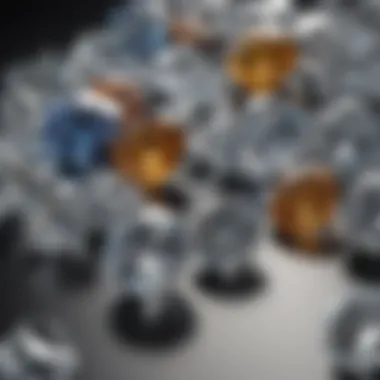

Intro
Diamonds have long captivated human attention, serving as symbols of wealth, power, and love. Yet, the evolution of diamond sourcing has introduced a significant conversation around the origin and nature of these gemstones. This article will draw a fine line between lab-created and natural diamonds, helping readers understand not only how they differ but also the implications of choosing one over the other. It’s not merely about which is more sparkling, but rather the intricate tapestry of ethics, economics, and geology underpinning each option.
Gemstone Overview
Definition and Characteristics
Gemstones, in general, are precious or semi-precious minerals that are cut and polished to produce jewelry. Diamonds, composed of carbon, are hailed as the hardest natural material and display remarkable optical properties. In their natural form, diamonds are formed deep within the Earth under extreme heat and pressure over millions of years.
Lab-created diamonds, conversely, replicate this natural process in a controlled environment, resulting in gemstones that are chemically, physically, and optically identical to their natural counterparts. Their defining characteristic is not their composition but their origin. So, while both types of diamonds may look indistinguishable to the naked eye, their histories are vastly different.
Classification of Gemstones
Gemstones can broadly be classified into three categories:
- Natural Gemstones: These are created by geological processes without human intervention.
- Synthetic Gems: These are human-made and include lab-created diamonds.
- Organic Gems: These gems are formed from living organisms, such as pearls and coral.
Economic Aspects of Diamonds
Both lab-created and natural diamonds find their way to a burgeoning market, influenced by public perception and pricing strategies. With lab-created diamonds generally being more affordable, they usher in a new era of accessibility. In contrast, the historical allure surrounding natural diamonds often allows them to command a higher price.
Historical Significance
Ancient Uses and Cultural Importance
For centuries, diamonds have held significant value in various cultures. Ancient civilizations believed that diamonds possessed healing powers and enhanced prosperity. They were often set into crowns and royal regalia, reflecting the status of kings and queens. Collectively, these aspects marked diamonds as not just mere ornaments but rather talismans imbued with deeper importance.
Myths and Legends Surrounding Gemstones
The lore surrounding gemstones is abundant, with diamonds often entwined in various myths. The Greeks attributed emotional strength to diamonds, believing that these gems conferred bravery and invincibility.
"Diamonds are a girl’s best friend," an adage merely underscores the social construct around the gemstone, illustrating how these stones have been mythologized in the modern era as well.
Preface
In an age where sustainability and ethical sourcing are garnering increasing attention, understanding the distinction between lab-created and natural diamonds becomes crucial. Diamonds have long been a symbol of love, commitment, and luxury, yet the way we acquire them can significantly influence their value and the world around us.
The journey of a diamond—from formation within the Earth's crust to its eventual place on your finger—varies greatly depending on its origin. Lab-created diamonds, being scientifically synthesized, offer a modern alternative to those mined from the ground. This not only affects their pricing but also raises questions about authenticity, desirability, and ethical considerations that many buyers now prioritize.
The importance of differentiating between these two types of diamonds is woven into various factors including:
- Cultural Significance: Natural diamonds carry a romantic and historical weight that many couples cherish. The lore surrounding them can influence perceptions and choices.
- Environmental Impact: With ongoing discussions about climate change and ecological balance, lab-created stones present a more environmentally friendly option.
- Cost Effectiveness: Lab-grown diamonds are typically less expensive, making luxury accessible to a broader audience without compromising quality.
Taking into account these factors, this article delves into the nuanced world of both lab-created and natural diamonds. We will traverse through their formation processes, physical characteristics, and the ethical implications surrounding their existence. By providing insight into market dynamics, quality evaluations based on the Four Cs, and shifting consumer preferences, readers will gain a rounded view of what truly matters when it comes to making informed choices in the diamond market.
"In today's rapidly changing landscape of consumerism, being informed is not just beneficial; it's imperative."
With everything on the table, we aim to equip gemstone enthusiasts, collectors, designers, and geology aficionados with the knowledge necessary to navigate their options intelligently. This engagement goes beyond the surface, fostering a deeper appreciation for these captivating gemstones.
Defining Diamonds
Understanding what constitutes a diamond is pivotal to unraveling the complexities of both natural and lab-created diamonds. This section not only sets the foundation for distinguishing these two variants but also emphasizes the intrinsic values and perceptions that surround them. For gemstone enthusiasts and collectors alike, grasping the essence of diamonds speaks volumes about the quality, allure, and cultural significance of these precious stones.
What constitutes a diamond?
Diamonds are not merely pretty rocks; they are a marvel of nature and science. At their core, diamonds are formed from carbon atoms arranged in a crystal structure known as a diamond lattice. This formation is what gives them their unparalleled hardness and brilliance. Their unique properties can be broken down into several key elements:
- Carbon Composition: Diamonds consist of a pure form of carbon. Under conditions of high temperature and pressure, this carbon crystallizes into the diamond structure.
- Crystal Structure: Each diamond showcases a tetrahedral arrangement of carbon atoms. This geometric configuration contributes to the stone's exceptional light dispersion, which creates the characteristic sparkle associated with diamonds.
- Hardness: Ranked the highest on the Mohs scale at 10, diamonds are not only beautiful but also extraordinarily durable. Their hardness makes them ideal for both jewelry and industrial applications.
- Optical Properties: The unique refractive properties of diamonds elevate their visual appeal. They possess a high refractive index, leading to a brilliant play of light that captivates observers.
Moreover, understanding what constitutes a diamond extends beyond its physical properties. Culture, history, and personal significance play a crucial role in how diamonds are perceived. For instance, the symbolism behind a diamond engagement ring transcends mere material value, representing love and commitment in many societies.
"A diamond is not just a luxury; it is a testament to human ingenuity and nature's artistry."
Understanding the very essence of diamonds helps consumers and collectors make informed decisions, weighing artistic value against scientific merit. The journey through the nuances of diamond characteristics not only enriches one’s knowledge but also enhances appreciation for these magnificent gemstones.
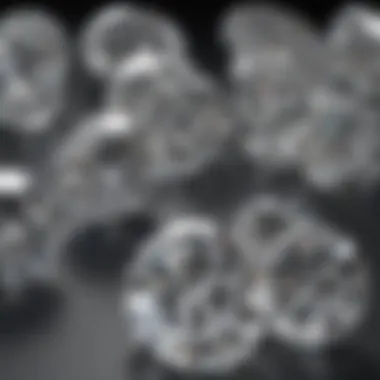
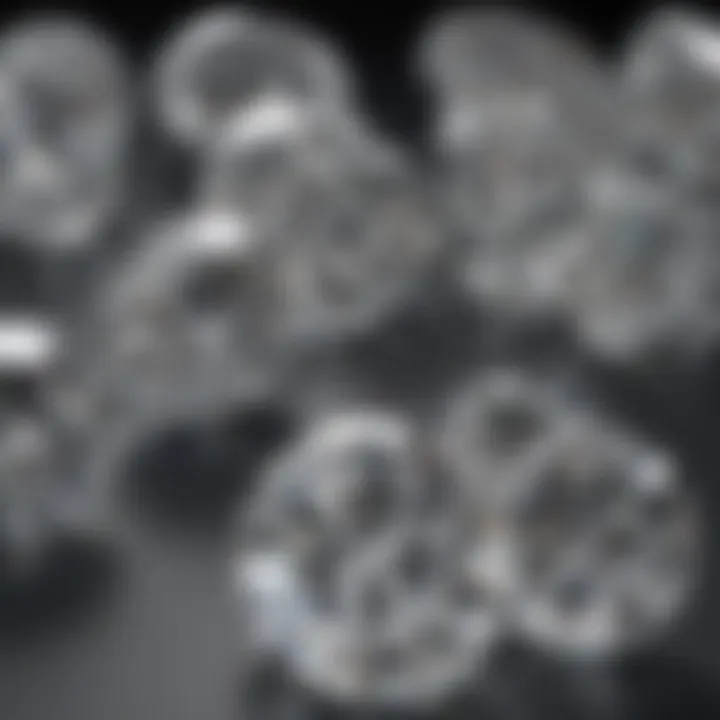
The Formation Process: Natural vs. Lab-Created
Understanding how diamonds form is crucial in differentiating between natural and lab-created varieties. The formation process impacts not only the appearance and qualities of the diamonds but also the ethical and financial implications surrounding them. Natural diamonds take millions of years to form under intense heat and pressure deep within the Earth’s mantle, while lab-created diamonds can be produced in a matter of weeks. This difference is pivotal, as it leads to varying perceptions regarding value, authenticity, and sustainability.
Natural Diamond Formation
Natural diamonds are forged through nature’s relentless forces. When carbon deposits burrow deep underground, the extreme conditions of heat—up to 1,500 degrees Celsius—and pressure—about 725,000 pounds per square inch—come into play. Over time, the carbon atoms bond in a crystal lattice structure, creating what we recognize as diamonds. This long and arduous process gives natural diamonds their unique character, including natural inclusions and color variations, which can tell the history of the Earth.
The rarity of natural diamonds largely contributes to their allure. The arduous journey to the surface, via volcanic eruptions, brings them to our world, making each one a treasure of geological history. However, the extraction of these gems often raises ethical questions. The mining process can cause significant environmental damage and may even fund conflicts in various regions.
Lab-Created Diamond Production Techniques
Just as fascinating is the technology that creates lab-created diamonds. The advancements in science have allowed gemologists to replicate the natural processes under controlled conditions. The two main techniques are High Pressure High Temperature (HPHT) and Chemical Vapor Deposition (CVD).
High Pressure High Temperature (HPHT)
HPHT simulates the natural conditions found in the Earth’s mantle. Carbon is placed in a chamber where pressure and heat are applied to mimic these extreme environments. One of the standout attributes of HPHT diamonds is their potential for flawless quality, as they are often free of inclusions that naturally occur in mined diamonds. This quality makes HPHT diamonds very appealing for consumers looking for ethical and high-quality gemstones.
However, the method has its drawbacks. The energy consumption for HPHT processes is significant. Critics often point out that while the labor may be ethically sourced, the energy used may not come from sustainable practices, which brings up questions about the overall environmental impact.
Chemical Vapor Deposition ()
CVD takes a different approach, using gases that contain carbon, such as methane. These gases are ionized and deposited on a substrate, gradually forming diamond layers. This technique allows for precision and offers the opportunity to tailor the diamond’s properties, enabling the creation of colored diamonds far more easily than in natural formations.
One notable feature of CVD diamonds is their reproducibility. Unlike natural diamonds that vary widely, CVD allows for a more uniform product, which contributes positively to market stability. Yet, CVD diamonds may not carry the same level of prestige as their natural counterparts, leading some buyers to value them less despite their similar qualities.
In summary, both HPHT and CVD techniques exhibit unique advantages and challenges. By understanding these processes, consumers and stakeholders gain insights into the underlying value, ethical considerations, and long-term impacts of their choices in diamonds. As the market evolves, this awareness becomes increasingly essential.
Physical Attributes and Composition
In the discussion of diamonds, particularly when contrasting lab-created and natural varieties, understanding physical attributes and composition is crucial. The tangible qualities that determine a diamond's appearance, feel, and overall value are what ultimately influences consumer choices and market trends. These attributes serve as a basis for evaluating the beauty and functionality of diamonds, making them a key topic in this analysis.
Physical attributes provide insights into how diamonds were formed, their durability, and even their resale value. Each diamond's unique qualities stem from its specific conditions of creation, whether deep within the Earth's mantle or in a controlled lab environment. This section will focus on two major aspects: crystal structure and hardness, as well as optical properties, both of which significantly impact a consumer's selection and appreciation.
Crystal Structure and Hardness
Diamonds are renowned for their incredible hardness, a result of their crystalline structure. Both lab-created and natural diamonds share the same crystal arrangement: a repeating pattern of carbon atoms bonded in a tetrahedral shape. This unique configuration allows diamonds to withstand scratching and resist wear better than most other gemstones.
Key Points About Crystal Structure:
- Inferior Hardness: On the Mohs scale, diamonds rank a perfect ten, making them the hardest known natural material. In simple terms, nothing can scratch a diamond but another diamond.
- Synthetic Integrity: Lab-created diamonds, using methods such as High Pressure High Temperature or Chemical Vapor Deposition, replicate the natural process of carbon crystallization. They exhibit the same physical properties and hardness as their natural counterparts.
- Internal Flaws: Despite their hardness, both natural and lab-created diamonds can have inclusions or imperfections, which can affect their durability and value. Natural diamonds may bear inclusions from their long formation process, while lab-created ones might have their own unique markers.
That said, the hardness factor plays a significant role in a diamond's appeal, particularly for consumers looking for engagement rings or pieces of jewelry that will be worn daily. A diamond's resilience directly adds to its desirability and market value, whether it is sourced from the depths of the earth or crafted in a laboratory.
Optical Properties
When it comes to a diamond's visual appeal, optical properties are fundamental. The way a diamond interacts with light not only defines its beauty but also its allure. This includes several aspects such as brilliance, fire, and scintillation, all of which affect a diamond's overall appearance.
Understanding Optical Properties:
- Brilliance: Refers to the brightness that comes from white light reflecting off a diamond’s surface. Both lab-created and natural diamonds can exhibit exceptional brilliance when cut properly.
- Fire: This characteristic describes the dispersion of light into various colors. A well-crafted diamond can show a rainbow effect, which adds to its charm.
- Scintillation: The sparkles and flashes of light that you see when a diamond moves are known as scintillation. This effect is present in both types of diamonds; however, the level of scintillation can vary depending on the cut class and quality.
"The remarkable optical characteristics of diamonds set them apart from other gemstones, making them a timeless choice for those who value beauty as much as durability."
In summary, the physical attributes and composition of diamonds, notably their crystal structure and optical properties, are pivotal aspects that help guide consumers in their purchasing decisions. As they navigate the landscape of diamond choices, understanding these features enhances appreciation and enables informed choices, whether one opts for the brilliance of a natural diamond or the precision of a lab-created one.
Evaluating Quality: The Four Cs
When it comes to understanding the true value and quality of diamonds, whether they are lab-created or natural, the Four Cs serve as essential criteria: cut, color, clarity, and carat weight. Each element plays a significant role in evaluating a diamond's overall worth and beauty. This section sheds light on how these criteria apply to both types of diamonds and why they are pivotal in making informed purchasing decisions.
Cut, Color, Clarity, and Carat Weight
The first aspect, cut, refers not just to the shape of the diamond, but how well it has been crafted. A diamond's cut affects its brilliance and sparkle. A well-cut diamond can reflect light beautifully, creating that sought-after dazzle. Lab-created diamonds are often cut to the highest standards, and many experts argue that their precision can often exceed that of natural diamonds, making them a compelling option for buyers.
Color, as the second criterion, describes the hue of the diamond itself, ranging from completely colorless to shades of yellow or brown. Both natural and lab-created diamonds are graded on a scale from D (colorless) to Z (light yellow). While natural diamonds may exhibit color due to the presence of trace elements, lab-created diamonds can be produced in a range of colors through controlled processes, offering consumers more choices.
Next up is clarity, which assesses the presence of internal imperfections, known as inclusions, and external flaws, called blemishes. Most diamonds, including those from natural occurrences, display some inclusions. However, lab-created diamonds tend to have fewer visible flaws due to the controlled environment in which they are grown. This gives lab-created diamonds an edge in clarity ratings, making them an attractive option for someone keen on quality.
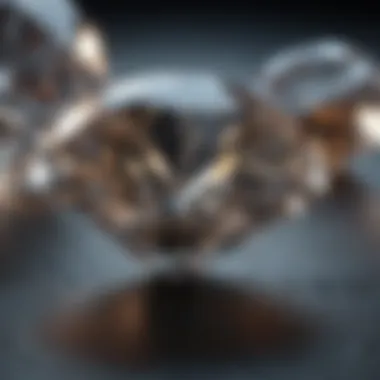
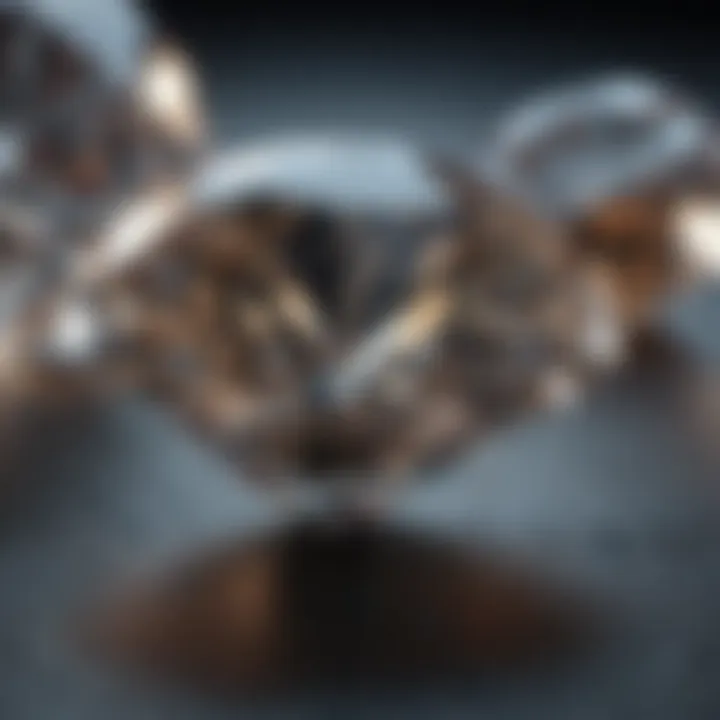
Lastly, carat weight measures the size of the diamond. A single carat equals 0.2 grams, and it’s a straightforward metric impacting pricing and perception. While the carat weight may hold the same value for both types, the cost per carat can differ significantly due to market dynamics and supply factors.
To summarize the Four Cs:
- Cut: Influences brilliance; exceptionally cut lab-created diamonds often dazzle more.
- Color: Ranges from D to Z; lab diamonds offer consistency in color grading.
- Clarity: Lab-created stones usually show fewer inclusions, appearing clearer.
- Carat Weight: Represents size but influences cost differently based on type.
"A diamond’s beauty lies in its cut, the color whispers its story, clarity defines its purity, and carat weight measures its significance."
Understanding the Four Cs is crucial for discerning consumers and enthusiasts in the diamond market. They serve as benchmarks for evaluating the quality of both natural and lab-created diamonds, ensuring that a knowledgeable decision is made when selecting the perfect stone.
Ethical Considerations
Ethical considerations related to diamonds have emerged as a prominent topic in recent years. As consumers become increasingly aware of the implications of their purchases, the distinction between lab-created and natural diamonds takes center stage. The journey of these gems from their origins to the consumer's hand can raise questions about labor practices, environmental sustainability, and the broader impact on communities involved in diamond mining. Understanding these aspects can greatly influence choices, guiding consumers toward selections that align with their values.
Sustainability and Environmental Impact
When it comes to sustainability, lab-created diamonds have a notable advantage over their natural counterparts. The formation of natural diamonds occurs deep within the Earth over millions of years, often requiring extensive mining practices that can devastate local ecosystems. The extraction process often leads to significant land degradation, pollution of water sources, and disruption of biodiversity. In contrast, lab-created diamonds are produced in controlled environments where energy and resources are utilized more efficiently, minimizing environmental harm.
Benefits of lab-created diamonds regarding sustainability include:
- Lower carbon footprint: The energy needed for creating lab-made diamonds often falls far below what is used in traditional diamond mining.
- Resource efficiency: With advanced technologies, these diamonds can be produced using methods like Chemical Vapor Deposition (CVD), which consumes considerably less water and energy.
- Less waste generation: The precision of lab processes reduces waste materials and ensures that resources are not extracted at an unsustainable rate.
"The choice of lab-created over natural diamonds can significantly contribute to a more sustainable future for the planet."
Consumers now find that by opting for lab-created diamonds, they can own beautiful gems without contributing to environmental degradation. This shift not only benefits consumers who want to showcase their ethics through their purchases but also encourages more sustainable practices in the jewelry industry as a whole.
Conflict-Free Status
The term conflict-free diamonds refers to gems mined without financing violence, oppression, or human rights abuses. This is a significant concern particularly surrounding natural diamond mining. Regions such as parts of Africa have a checkered history with diamonds fueling conflict—often referred to as "blood diamonds". These stones have been linked to wars and severe human rights violations, raising the stakes for ethical consumers.
Lab-created diamonds, by virtue of their production method, inherently avoid these issues. Since they are crafted in labs, they do not come from mines plagued by ethical dilemmas.
Some specific points regarding the conflict-free status include:
- Guaranteed origin: Lab-created diamonds provide clear provenance, allowing consumers to feel confident that their purchase did not contribute to violence.
- Transparency: Unlike natural diamonds, where the mining process can be opaque, lab-created diamonds are made with traceable methods, allowing consumers to ensure ethical sourcing.
- Social responsibility: Choosing lab-created stones can support practices that prioritize the welfare of workers and communities over profit motives that often back unethical mining operations.
In essence, the issues surrounding conflict-free status elevate the importance of making informed decisions when selecting diamonds. Consumers now prioritize where their gemstones come from and the implications that their purchases carry, seeking to endorse markets that promote ethical practices.
The rise of conscious consumerism is reshaping the diamond industry, promoting greater accountability and respect for human rights. Through an understanding of these ethical considerations, buyers can not only enjoy the beauty of their gems but also stand by their principles.
Market Dynamics and Pricing
Understanding the market dynamics and pricing of diamonds is a critical aspect of distinguishing between lab-created and natural diamonds. The differences in their formation processes significantly influence their availability, value, and consumer perception. This section sheds light on how market forces, consumer choice, and pricing structures intertwine, offering valuable insights for both potential buyers and industry players.
Cost Comparison
When diving into the realm of diamond pricing, a clear divide emerges between natural and lab-created diamonds. On one hand, lab-created diamonds typically carry a price tag that is 30% to 50% lower than their natural counterparts. This price difference can be attributed to several key factors:
- Production Costs: Lab-created diamonds require advanced technology and machinery, yet economies of scale in production keep these costs down. Natural diamonds, however, are often subject to the whims of mining operations, which can be unpredictable and costly.
- Rarity: Natural diamonds are formed over billions of years under specific circumstances, making them scarce. The perception of rarity often enhances their value among some consumers. Meanwhile, lab-grown diamonds can be produced in abundance, which stabilizes their prices in the marketplace.
- Market Demand: Buying preference plays a significant role in cost. As consumer awareness regarding ethically sourced and sustainable gems grows, lab-created diamonds are increasingly appealing to a wider audience, affecting their pricing. Despite the price difference, the shift in consumer sentiment is pushing natural diamond prices to adjust gradually.
- Resale Value: Natural diamonds retain better resale value thanks to the long-standing perception of their worth. Sellers often find that lab-created diamonds depreciate more quickly, which is something to consider when making a purchase.
Market Perception and Trends
The perception of diamonds in the marketplace is evolving at an unprecedented pace. More consumers today are weighing their options between lab-created and natural diamonds, often influenced by ethical considerations and personal values.
- Changing Mindsets: The stigma that once surrounded lab-created diamonds is fading. They're increasingly viewed as a viable alternative to natural diamonds, especially among younger generations. Consumers are more inclined to prioritize sustainability and ethical sourcing, prompting a shift in buying patterns.
- Emergence of Retail Brands: Numerous brands are now adopting freshness in this space by promoting the benefits of lab-created diamonds. Retailers are keen to emphasize ethical practices, affordability, and quality that lab diamonds offer, often turning them into style statements rather than just products.
- Influencer Impact: Social media platforms also play a significant role in shaping market perceptions. When influencers promote lab-grown diamonds, citing their reduced environmental impact, it can sway public opinion and affect demand within the market. Anecdotal evidence suggests that diamonds featured in high-profile engagements have notably increased interest in lab-grown options.
- Economic Fluctuations: External factors, such as economic stability, also affect consumer purchasing power and sentiment. In uncertain times, buyers may lean more toward cost-effective options without compromising quality, increasing the appeal of lab-grown diamonds. As a result, lab-created diamonds fluctuate in consumption trends reflecting broader economic conditions.
Overall, the dynamics of the diamond market reveal a much more complex narrative than once perceived. The challenges natural diamonds face from lab-created alternatives push the boundaries, causing both to adapt and thrive in an ever-evolving marketplace.
"A diamond is a chunk of coal that did well under pressure," but today, both natural and lab diamonds have distinct paths to brilliance.
Consumer Preferences and Choices
Understanding consumer preferences when it comes to diamonds is crucial, especially as the market evolves with lab-created alternatives. Those seeking diamonds usually face a significant decision: whether to choose a lab-created diamond or a natural one. This choice can be influenced by various factors, including personal values, financial considerations, and aesthetic desires, as well as broader social implications tied to sustainability and ethics.
Additionally, consumer choices reflect changes in societal attitudes. Younger generations often prioritize environmental consciousness and ethical considerations, leading them to lean towards lab-created options. However, sentimental value often attached to natural diamonds remains strong, especially when considering tradition and heritage. Evaluating these contradictions provides insight into broader consumer behavior, thus shaping future trends in the diamond industry.
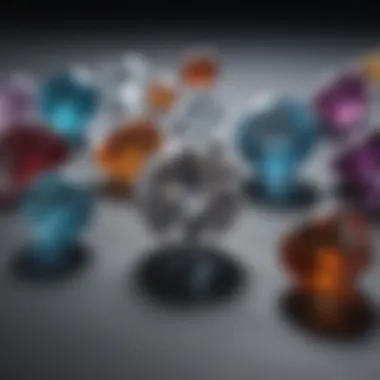
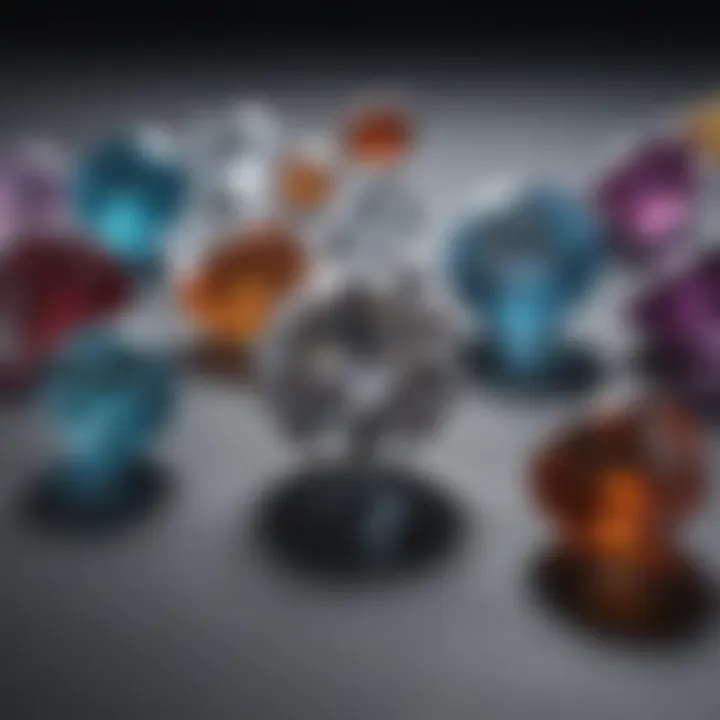
Reasons for Choosing Lab-Created Diamonds
Lab-created diamonds appeal to many consumers for several reasons:
- Cost-Effectiveness: Generally speaking, these diamonds come with a lower price tag than their natural counterparts, allowing consumers to stretch their budgets further.
- Ethical Assurance: There’s a growing concern about conflict diamonds, which can fund violence. Lab-created diamonds eliminate this worry as they’re produced in controlled environments, making them inherently conflict-free.
- Environmental Concerns: The mining of natural diamonds can pose significant environmental risks. Lab-created diamonds promise a more sustainable option, often requiring less land disruption and fewer resources.
- Customizability: Many labs allow consumers to tailor their stones, adjusting elements like color and clarity far more than what one might find in nature.
In essence, lab-created diamonds offer a combination of affordability and ethical peace of mind that appeals to a broad audience. For those who value these traits, the choice may feel like a no-brainer.
Reasons for Choosing Natural Diamonds
While lab-created diamonds have distinct advantages, many consumers remain steadfast in their preference for natural diamonds. Here are key factors driving this preference:
- Tradition and Sentimentality: Natural diamonds carry a sense of history. They are often viewed as heirlooms, passed down through generations, symbolizing love, commitment, and milestones. Their rarity adds to their allure.
- Perceived Value: Despite often being more expensive, natural diamonds are associated with greater value and status. Many people believe that owning a natural diamond endows a piece of jewelry with a special significance.
- Unique Characteristics: Every natural diamond has distinct traits born from its formation over millions of years. This uniqueness often attracts consumers who appreciate one-of-a-kind pieces.
- Market Trends: The appraoch of traditional jewelry markets has heavily focused on natural diamonds, affecting resale value and consumer preferences over time.
Buying a natural diamond is often seen as a mark of authenticity—a tangible connection to Earth’s past. For many, this relationship can outweigh the practical advantages offered by lab-created stones.
"In a world where choices abound, understanding the motivations behind diamond preferences unravels the broader narrative of our societal values and the directions we're heading."
Ultimately, the decision rests on individual preferences, values, and contexts. The diamond consumers are not just buying stones; they're making statements about themselves, their values, and what they wish to represent in their lives.
Future Outlook for Diamond Industry
In the contemporary landscape of gemstones, understanding the future outlook for the diamond industry holds significant merit. With the constant evolution in technology and shifts in consumer preferences, both lab-created and natural diamonds face a changing market. Recognizing how these sectors adapt to trends and technological advancements strengthens the insight for various stakeholders, ranging from buyers to jewelers.
Technological Advancements
Technology in diamond production continues to leap forward, concentrating on enhancing quality and efficiency. Innovations in High Pressure High Temperature (HPHT) and Chemical Vapor Deposition (CVD) methods significantly raise the bar on what lab-created diamonds can achieve.
- Quality Improvement: Recent advancements enable manufacturers to produce diamonds that are nearly identical to their natural counterparts in terms of clarity and color.
- Cost Reduction: With increased efficiency, production costs for lab-created diamonds have significantly dropped, which can lead to lower retail prices.
- Customization Options: Technology allows for personalization, appealing to consumers looking for unique pieces that emit a sense of individuality.
These strides in technology not only impact the way diamonds are produced but also structure the market's future. The increased accessibility of diamonds might alter consumers’ perceptions, blur the lines between lab-created and natural stones, and potentially reshape competitive strategies among jewelry retailers.
Shifts in Consumer Behavior
The diamond market is not immune to the changing tides of consumer habits. As values and preferences evolve, buyers are doing their homework.
- Preference for Sustainability: More consumers seek eco-friendly options. Lab-created diamonds generally have a smaller environmental impact, often leading buyers to favor them over mined diamonds.
- Informed Decision-Making: Buyers are not just going for the sparkle; they're considering ethical implications, perceived quality, and cost-effectiveness. A well-informed buyer today understands the distinctions, enabling them to choose diamonds that align with their values.
- Social Influences: Social media, especially platforms like Facebook and Reddit, have become crucial information sources. People share experiences and opinions about their buying choices, creating discussions that influence others.
"Understanding the changing preferences among consumers is key to forecasting the industry's future; it helps manufacturers and retailers adapt quickly to trends or risk falling behind."
Closure
In this exploration of lab-created versus natural diamonds, the final thoughts touch on a myriad of complexities that shape consumer choices today. This discussion is crucial not only for jewel seekers but also for those invested in the broader implications of their purchase decisions.
When a consumer decides which type of diamond to invest in, they're not merely considering aesthetics or pricing. They're contemplating environmental concerns, ethical implications, and even how their selection aligns with personal values. This importance is underscored by:
- The difference in formation processes, making natural diamonds a product of millions of years versus the relatively short time span required for lab-created stones.
- The ethical conversation around sourcing and labor practices is amplified, especially in a world increasingly conscious of sustainability and human rights.
- Market fluctuations that drive perceptions and trends, adding layers to the decision-making process.
For gemstone enthusiasts, collectors, and jewelry designers, the implications of choosing between these two categories go beyond mere sparkle. The ongoing evolution in technologies and consumer behaviors points toward a shifting landscape in the diamond industry. As the dialogue continues, it invites individuals to consider their roles as informed consumers within this dynamic market.
Understanding these elements aids in making choices that are not only financially sound but also reflect moral and cultural commitments. Reflecting on this enhances the overall narrative of what diamonds represent in our lives—symbols of love, commitment, and now, with growing awareness, of responsibility.
"A diamond is forever, but it's important to remember what it truly represents in our unique stories."
References and Further Reading
Understanding the nuances between lab-created and natural diamonds goes beyond mere discussions about aesthetics and price. References and further reading on this topic offer immense benefits, especially for those involved in the gemstone industry, including enthusiasts, collectors, jewelry designers, and geology aficionados.
Importance of References
Diving into reputable sources enables one to grasp the technicalities of diamond formation, the complexities involved in ethical trading, and the evolving market dynamics. With the constant advancements in technology, staying updated on methods used to cultivate lab-created diamonds—such as High Pressure High Temperature and Chemical Vapor Deposition—profoundly impacts how one perceives these gemstones. Here are some key advantages that come from engaging with further literature:
- Deepens Knowledge: It equips readers with insights about the formation processes of both natural and lab-created diamonds.
- Clarifies Misconceptions: Many people still harbor biases or misunderstandings about lab-created diamonds. Quality literature can dispel myths.
- Informed Decisions: For consumers looking to make choices aligned with their values—be it sustainability or supporting ethical mining—knowing where to find validated information is crucial.
Recommended Resources
To expand your understanding of diamonds, consider checking out the following resources:
- Wikipedia - Diamond: A broad overview of diamond types, properties, and uses.
- Britannica - Diamonds: Detailed articles about the history, formation, and significance of diamonds.
- Reddit - Gemstone Community: A platform where enthusiasts can share experiences, insights, and ask questions.
- Facebook - Gemstone Groups: Join groups dedicated to diamond discussions to connect with like-minded individuals and experts.
In summary, references and further readings play a pivotal role in navigating the diamond landscape, helping enthusiasts and professionals solidify their knowledge and opinions about these exquisite gemstones. Engaging with diverse sources provides clarity, enriches one's perspective, and aids in making educated decisions in a field where information is just as valuable as the gems themselves.
"An investment in knowledge always pays the best interest." - Benjamin Franklin.







